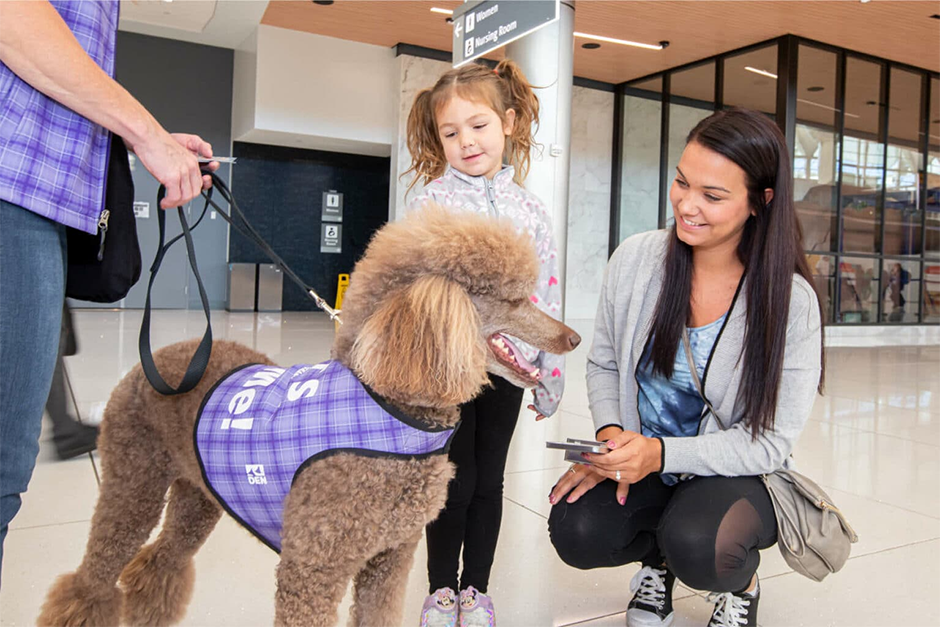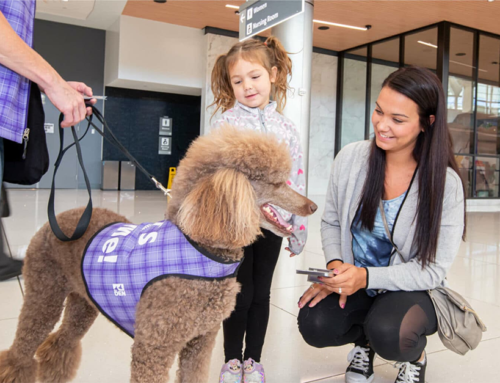
A Therapy dog is a dog that is trained to provide comfort, affection, and emotional support to people in various settings, such as hospitals, nursing homes, schools, and disaster areas. Unlike service dogs, therapy dogs are not trained to perform specific tasks related to a disability, nor do they have the same legal protections as service dogs. Instead, their role is to offer emotional well-being and support through their presence.
Therapy Dog Access:
- Hospitals and healthcare facilities (with permission)
- Nursing homes and assisted living facilities
- Schools and universities (with permission)
- Libraries and reading programs
- Community centers
- Rehabilitation facilities
- Disaster response sites
- Airports (as part of stress-relief programs)
- Prisons and correctional facilities (as part of therapy programs)
Note: Therapy dogs do not have the same public access rights as service dogs and typically require prior permission to enter these spaces.
Key Points About Therapy Dogs:
- Roles and Settings:
- Hospitals and Nursing Homes: Therapy dogs visit patients to help reduce stress, anxiety, and depression. Their presence can be soothing and may even promote faster recovery by improving patients’ mood and motivation.
- Schools and Libraries: Therapy dogs are often used in educational settings to help children with learning disabilities or to reduce anxiety in students during stressful times, such as exams. Programs like “Reading to Dogs” encourage children to read aloud to therapy dogs, which can help improve their literacy skills and confidence .
- Disaster Areas: After traumatic events, therapy dogs are brought in to provide comfort to victims, first responders, and volunteers. Their calming presence can help individuals process grief and trauma .
- Training and Certification:
- Therapy dogs undergo specific training to ensure they are well-behaved, calm, and able to interact safely with a wide range of people. This training focuses on socialization, obedience, and comfort-providing behaviors rather than task-specific training like that of service dogs.
- Many organizations offer certification for therapy dogs, such as Therapy Dogs International (TDI) and Pet Partners. These organizations evaluate the dog’s temperament, behavior, and ability to provide comfort in various settings .
- Legal Considerations:
- Therapy dogs do not have the same legal rights as service dogs under the Americans with Disabilities Act (ADA). They are not allowed to enter public places where pets are typically not permitted unless they have been granted special permission as part of a therapy program.
- Institutions or facilities must grant permission for therapy dogs to visit. These visits are often part of organized programs where therapy dog handlers, who are typically volunteers, bring their dogs to specific locations to interact with people .
- Differences from Service and Emotional Support Animals:
- Service Dogs: Service dogs are trained to perform specific tasks for individuals with disabilities and have legal protections under the ADA, allowing them to access public spaces with their handlers.
- Emotional Support Animals (ESAs): ESAs provide comfort to individuals with emotional or psychological conditions but do not require special training to perform specific tasks. While ESAs have some legal protections, particularly in housing, they do not have the same access rights as service dogs .
Additional Resources:
- Therapy Dogs International (TDI): Information on becoming a certified therapy dog team.
- Pet Partners: Another major organization for therapy animal registration and information.
- AKC Therapy Dog Program: The American Kennel Club’s program for recognizing therapy dogs.
Therapy dogs play a crucial role in improving the emotional well-being of individuals in various settings, and their presence is increasingly recognized as a valuable component of therapy and care.

A Therapy dog is a dog that is trained to provide comfort, affection, and emotional support to people in various settings, such as hospitals, nursing homes, schools, and disaster areas. Unlike service dogs, therapy dogs are not trained to perform specific tasks related to a disability, nor do they have the same legal protections as service dogs. Instead, their role is to offer emotional well-being and support through their presence.
Therapy Dog Access:
- Hospitals and healthcare facilities (with permission)
- Nursing homes and assisted living facilities
- Schools and universities (with permission)
- Libraries and reading programs
- Community centers
- Rehabilitation facilities
- Disaster response sites
- Airports (as part of stress-relief programs)
- Prisons and correctional facilities (as part of therapy programs)
Note: Therapy dogs do not have the same public access rights as service dogs and typically require prior permission to enter these spaces.
Key Points About Therapy Dogs:
- Roles and Settings:
- Hospitals and Nursing Homes: Therapy dogs visit patients to help reduce stress, anxiety, and depression. Their presence can be soothing and may even promote faster recovery by improving patients’ mood and motivation.
- Schools and Libraries: Therapy dogs are often used in educational settings to help children with learning disabilities or to reduce anxiety in students during stressful times, such as exams. Programs like “Reading to Dogs” encourage children to read aloud to therapy dogs, which can help improve their literacy skills and confidence .
- Disaster Areas: After traumatic events, therapy dogs are brought in to provide comfort to victims, first responders, and volunteers. Their calming presence can help individuals process grief and trauma .
- Training and Certification:
- Therapy dogs undergo specific training to ensure they are well-behaved, calm, and able to interact safely with a wide range of people. This training focuses on socialization, obedience, and comfort-providing behaviors rather than task-specific training like that of service dogs.
- Many organizations offer certification for therapy dogs, such as Therapy Dogs International (TDI) and Pet Partners. These organizations evaluate the dog’s temperament, behavior, and ability to provide comfort in various settings .
- Legal Considerations:
- Therapy dogs do not have the same legal rights as service dogs under the Americans with Disabilities Act (ADA). They are not allowed to enter public places where pets are typically not permitted unless they have been granted special permission as part of a therapy program.
- Institutions or facilities must grant permission for therapy dogs to visit. These visits are often part of organized programs where therapy dog handlers, who are typically volunteers, bring their dogs to specific locations to interact with people .
- Differences from Service and Emotional Support Animals:
- Service Dogs: Service dogs are trained to perform specific tasks for individuals with disabilities and have legal protections under the ADA, allowing them to access public spaces with their handlers.
- Emotional Support Animals (ESAs): ESAs provide comfort to individuals with emotional or psychological conditions but do not require special training to perform specific tasks. While ESAs have some legal protections, particularly in housing, they do not have the same access rights as service dogs .
Additional Resources:
- Therapy Dogs International (TDI): Information on becoming a certified therapy dog team.
- Pet Partners: Another major organization for therapy animal registration and information.
- AKC Therapy Dog Program: The American Kennel Club’s program for recognizing therapy dogs.
Therapy dogs play a crucial role in improving the emotional well-being of individuals in various settings, and their presence is increasingly recognized as a valuable component of therapy and care.






